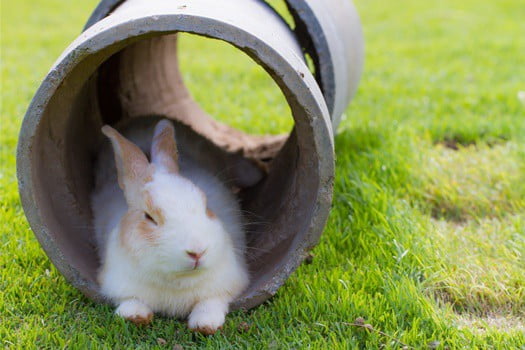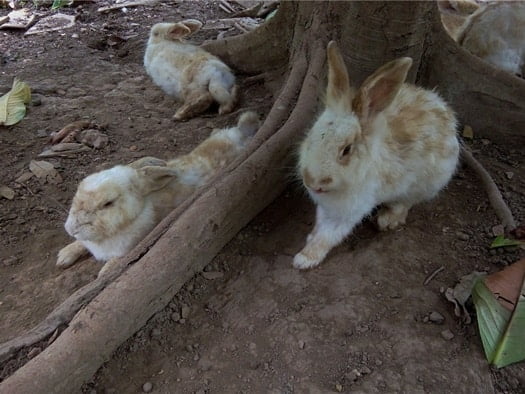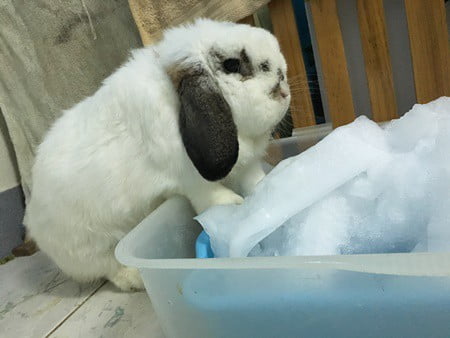Rabbits don’t cope well with high temperatures. Their thick fur, which helps keep them warm in the winter, is a hindrance in very warm weather. Fortunately, there are ways you can prevent overheating in rabbits, even on the hottest days.
Keep your rabbit’s enclosure shaded, and no hotter than 70 degrees. If indoors, use a fan to blow air past your rabbit. Offer plenty of cold water and vegetables, and a chilled ceramic tile to lie on. Leave frozen bottles of water in your rabbit’s enclosure to help cool the air.
Hyperthermia in rabbits can be fatal. We’ll discuss how to keep your rabbit cool, whether they live indoors or outdoors. We’ll also explain the signs of overheating, and how you can treat it.
How Hot is Too Hot for a Rabbit?
Normally, rabbits are good at maintaining a consistent body heat. Their internal temperature usually stays between 101 and 103 degrees Fahrenheit, whatever the weather outside.
Wild European rabbits are built to deal with extreme temperatures. Winters in Europe often freeze, bringing snow and ice. And the heat of summer can be sweltering, especially closer to the equator.
Due to their dense fur coats, rabbits can easily handle cold temperatures. Warm weather, however, poses more of a challenge. It’s easy for a small, furry body to become too hot in the summer.
In the wild, rabbits cope by hiding out in underground warrens. There, they can stay away from the heat of the sun during the hottest part of the day. They’ll emerge only at dawn and dusk, when the sun is low in the sky.
Pet rabbits, however, can’t build themselves cool, subterranean burrows. It’s up to us to ensure that the temperature in their environment stays cool at all times.
The ideal ambient temperature for a pet rabbit is between 55 and 70 degrees Fahrenheit. If necessary, they can withstand temperatures up to 80 degrees, though they may be in some discomfort.
However, when the temperature rises to 85 degrees Fahrenheit, rabbits are at risk of overheating.
Breeds with shorter coats, such as Dutch rabbits, may be able to deal with heat more easily. But long-haired rabbits, such as Angoras and Lionheads, may overheat quickly.
Can Rabbits Overheat?
All animals can overheat if their environment is hot enough. Thick-furred animals, such as rabbits, are at most risk. If a rabbit’s body temperature becomes too high, this is called hyperthermia.
Many animals have mechanisms which help them stay cool, such as sweating and panting. Rabbits can’t sweat or pant. They can lose some heat through their ears, but if temperatures are too high, this isn’t enough.
Interestingly, in controlled settings, hyperthermia can treat malignant cancer in rabbits. According to the British Journal of Cancer, cancerous cells in rabbits die at extreme temperatures.
However, under normal circumstances, hyperthermia can be dangerous. It can lead to a condition called heat stroke, which can be fatal.

Rabbits can overheat whether they live indoors or outdoors. And humans can withstand temperatures over 10 degrees higher than rabbits can. So even if you feel OK, your rabbit might not.
The risk of hyperthermia is particularly high if your rabbit’s enclosure is in direct sunlight. Patches of earth or flooring can quickly become too hot in the sun. Wall-mounted thermometers aren’t always a good guide, as the air temperature may be lower than the floor.
Humidity can also factor into the equation. Humid air can be stifling, and make rabbits overheat more quickly than in dry air.
Your rabbit can’t tell you if he’s feeling too hot, so it’s up to you to notice the signs. Your rabbit will start to become uncomfortable before you do, so you must stay vigilant.
What are the Signs of Overheating in Rabbits?
Hyperthermia isn’t always obvious. Rabbits don’t tend to broadcast when they’re uncomfortable or in pain. This is because, in the wild, a distressed rabbit would be an easy target for predators.
However, just because it isn’t obvious, that doesn’t make it any less dangerous. If a rabbit experiences hyperthermia for an extended period of time, it can easily lead to heatstroke.
According to research in Experientia, heatstroke begins when high temperatures lead to restricted blood flow to the brain. This can cause brain damage, including seizures. It can quickly lead to death if not treated. Signs of hyperthermia in rabbits include:
- Ears and feet which are warm to the touch
- Lethargy and weakness
- Restlessness and an inability to get comfortable
- Rapid breathing and nose-twitching
- Breathing with mouth open
- Unresponsiveness
- Lack of appetite
- Tossing of the head
If hyperthermia has progressed to heatstroke, you may notice more severe symptoms. These include:
- Incoordination and confusion
- Blue-tinged nose and mouth
- Wet nose and salivating
- Collapse
- Seizures or convulsions
Hyperthermia is a medical emergency in rabbits. If it is not dealt with quickly, your rabbit could die. That’s why it’s crucial to learn the symptoms, so that you can intervene if necessary.
Do Rabbits Pant?
Some animals use methods to cool themselves down that rabbits do not. This is why it can be tricky to notice when your rabbit becomes too hot.
Panting is common in certain animals. This rapid, open-mouth breathing is quite normal in the heat. It helps the animal to cool down and is not usually a cause for concern.
Rabbits, however, cannot pant to keep cool. Rabbits always breathe through their nose, unless there is something seriously wrong.
If your rabbit appears to be “panting,” this is a sign that hyperthermia has already set in. By this point, it’s too late for the rabbit to cool themselves down without your help.
Similarly, rabbits cannot perspire (sweat) to cool themselves down, as we do. They have some sweat glands, but very few, and not enough to have any effect on body temperature.
How to Prevent Hyperthermia in Rabbits
Keeping a rabbit’s temperature low in the first place is easier than bringing down its temperature. Here are some tips to help prevent your rabbit from overheating:
- If your rabbit lives indoors, keep your thermostat set between 55 and 70 degrees Fahrenheit.
- For outdoor rabbits, position their entire enclosure – including hutch and run – somewhere that is in shade all day long.
- Ensure that your rabbit does not become overweight. Extra fat acts as an insulating layer, meaning your rabbit will overheat quicker.
- Groom your rabbit every day in the spring and summer. Getting rid of loose hairs can help a rabbit stay cool.
- Give your rabbit access to unlimited water. Check and refill the bowl regularly in warm weather.
- Minimize stress. Stressful situations can cause a rabbit’s body temperature to rise. Don’t chase or pick up your rabbit, or expose him to loud noises.
- If your rabbit is a long-haired breed, such as a Lionhead or an Angora, consider trimming their coat. Don’t attempt to trim the face or feet.
If you live somewhere with moderate summers, the above tips should be sufficient in keeping your rabbit cool. However, if your rabbit does become too hot, there are ways of cooling rabbits down.
How to Keep Rabbits Cool Inside
In summer, it’s easier to keep an indoor rabbit cool than an outdoor rabbit. The walls of your home provide natural insulation against extreme hot weather. Not to mention, most homes are fitted with air conditioning, which is invaluable.
If you don’t have air conditioning, however, your rabbit could become too hot. This is especially likely if you live in a humid part of the world. Or, if your rabbit’s enclosure is near a window that provides direct sunlight. To cool down an indoor rabbit, try the following tips:
- Place your rabbit’s enclosure on a tiled floor, rather than carpet or wood. It should be in a shaded area, away from windows.
- Set up an electric fan to blow into your rabbit’s enclosure. Place it an angle such that your rabbit can escape the breeze if they wish. Ensure your rabbit can’t access the cord.
- Offer cold vegetables fresh from the fridge, rather than at room temperature.
- Place ice cubes in your rabbit’s water dish. Replace them when they melt. Refill the bowl often to ensure your rabbit has a constant supply of water.
If your rabbit is still too warm, you may consider moving their enclosure into a cooler room. Take the temperatures of each room in your home and choose the coldest one. This may be the basement.
How to Keep Outdoor Rabbits Cool in Summer
It can be difficult to keep your rabbit cool during summer if they live outdoors. The most important thing to consider is shade.
As the sun moves during the day, your rabbit’s enclosure may move into our out of the sun. So, choose a spot for the hutch and run that is at least partially shaded at all times. If your yard gets a lot of sunlight, you could:
- Move your rabbit into an outdoor building, such as a storage shed. It should be well ventilated, with access to an outdoor run.
- Plant shrubs or vegetation around your rabbit’s enclosure to provide shade. Keep them out of reach, so that your rabbit can’t eat them.
- Drape a sheet, canvas or towel over your rabbit’s enclosure. You can also dampen the covering. As the water evaporates, it will help keep your rabbit cool.
As well as providing shade, there are other measures you can take to help keep your rabbit cool.
- A ceramic tile makes a great rabbit cooling pad. Place it in a shaded part of the enclosure. Ceramic stays cool for a long time, and your rabbit will enjoy lying on it. You can chill the tile in the fridge first.
- Offer your rabbit occasional snacks of frozen fruits and vegetables. Provide plenty of fresh greens too.
- Place frozen bottles of water inside the pen. They’ll help keep the air temperature cool, and your rabbit will love snuggling up to them.
Keep a close eye on your outdoor rabbit during hot weather. Regularly check that they’re not showing any signs of heatstroke.
Should I Keep My Rabbit Indoors in Summer?
In hot climates, rabbits can’t cope with the heat of summer. If you’re noticing any signs of hyperthermia in your outdoor rabbit, you should consider moving them indoors.
Rabbits can live indoors easily. They will relish being in a cool environment, protected from the sun. As long as you provide enrichment, such as toys, they won’t miss the outside. And you can move them outdoors again once the weather starts to cool.
As a bonus, rabbits can be trained to use a litter box. Fill a large plastic tray with paper litter and top it with hay (as rabbits like to poop while eating).
If you plan to let your rabbit run free indoors, ensure that your home is rabbit-proofed. Keep all electrical cords, houseplants and anything you don’t want to be chewed out of the way.

How to Treat Heat Stroke in Rabbits
If you follow the above guidelines, your rabbit should remain cool enough to avoid hyperthermia. Constant access to shade and cool water can go a long way in preventing overheating in rabbits.
However, if you live in a hot climate, stay vigilant. Heatstroke can occur in rabbits at any time during summer. Rabbits are more sensitive to heat than we are.
During the warmer months, keep checking your rabbit during the day, whether they live indoors or outdoors. If you notice any signs of hyperthermia, take action immediately to cool your rabbit down.
- Move your rabbit inside your home, to the coolest place available. For example, set them in the kitchen, near the refrigerator with the door open.
- Fill a spray bottle with cool water. Using the ‘mist’ setting, spray your rabbit’s ears, feet and underside (belly).
- Use a blow dryer on the ‘cold’ setting to blow air over your rabbit. Don’t aim the air directly at their face.
Following these steps, your rabbit should cool down fairly quickly. The signs of hyperthermia will start to subside.
If this doesn’t happen, or the symptoms get worse, take your rabbit to an emergency veterinarian. Heatstroke can be fatal, so if you are in any doubt, err on the side of caution. Wrap your rabbit in a damp towel and transport them in an air-conditioned car if possible.
What to Avoid When Cooling a Rabbit Down
There are certain things you should avoid doing when trying to keep your rabbit cool. Cooling your rabbit down in the wrong way can be dangerous.
- Do not dip your rabbit into water. Rabbits do not like water, so baths are stressful for them. If the water is cold, they may go into shock, which can be fatal.
- Do not overfeed your rabbit frozen treats. Though frozen food can help cool your rabbit down, it can also inhibit digestion. According to research in Gut, cold food and drink can slow down the digestive system, which could be dangerous in rabbits.
- Don’t cool your rabbit down too much. Hypothermia can be as dangerous as overheating. A rabbit’s body temperature should not be lower than 101.3 degrees Fahrenheit.
If anything you are doing appears to be distressing your rabbit, stop straight away. Stress is dangerous to rabbits, as fright can cause them to go into cardiac arrest. Though this is rare, it’s not worth the risk.
Can Rabbits Recover from Heat Stroke?
It’s easy to forget how quickly a pet can begin to overheat in the summer. Rabbits can’t tell you that they’re too hot, so it’s up to you to recognize the signs.
All animals can die from heatstroke. Animals like rabbits, with thick fur coats, are at particularly at a risk. An article in the Los Angeles Times highlighted that even police dogs have died from hyperthermia while on the job.
Heatstroke can result in lasting damage if it is not dealt with in time. However, it is not always a death sentence for rabbits. If you intervene at the first signs of overheating, your rabbit has a better chance.
Closely monitor your rabbit throughout the day. Take all reasonable steps to cool your rabbit down if they appear to be too hot. If your efforts don’t seem to be working, take your rabbit to an emergency veterinarian straight away.
A veterinarian will be able to use intravenous fluids to cool your rabbit down. This will also help keep your rabbit hydrated.

